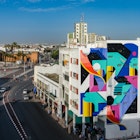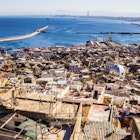

Sunset on Place El Hedim. Rolf Bach / Getty Images
Each day when dusk sets in over Meknes, the sunвҖҷs last hurrah dances across the cityвҖҷs Imperial gateway, Bab El Mansour. For a few lingering minutes, the hulking gate burns like Saharan sand in front of a local audience clutching shopping bags rather than cameras. Tourists are few and far between. Lacking the vast medieval medina of neighbouring Fez or the burgeoning fusion scene of Marrakesh, this imperial cityвҖҷs lineage as a one-time capital of Morocco hasnвҖҷt helped secure it a spot on many travel itineraries.
The city's relative obscurity makes Meknes a breath of fresh air. Food is cheaper, if a little samey, and the cityвҖҷs mid-range riad scene has exploded in the past few years with enough charm and class to rival Fez and Marrakesh, but at half the price. Best of all are the epitaphs to Moulay IsmailвҖҷs 17th-century reign: three sets of fortifications still partially entwined with the urban landscape and plenty of unique relics to explore. Visit and you won't leave disappointed.

Morning
The one site in Meknes most likely to receive a bottleneck of tourists is the Mausoleum of Moulay Ismail, so start the day here to avoid tiptoeing around large crowds. The tomb is a tour de force of Moroccan craftsmanship that befits a sultan whose family were descendants of the Prophet Muhammad, who courted the daughter of FranceвҖҷs King Louis XIV and who waged merciless military campaigns to bring Morocco under his iron fist. Ismail (1672-1727) moved the capital from Marrakesh to Meknes, signalling a period of cultural flowering for the city that swiftly crumbled after his death. In 2018, the sanctuary is set to emerge triumphantly from a two-year refurbishment.
Across the road from Moulay IsmailвҖҷs sanctuary, within the walls of the original imperial city, Koubbat As Sufara gives a taster of what can be seen later in the day at Heri Es Souani: a subterranean network of rooms thought to have been a food store. Or, depending on whoвҖҷs guiding you, a dungeon for IsmailвҖҷs Christian slaves. Before lunch, head back to MeknesвҖҷ central Place El Hedim to find the Dar JamaГҜ Museum, a romantically dishevelled 19th-century palace, which has been converted into a museum of traditional textiles, cedarwood crafts, and jewellery. Its bird-filled Andalucian courtyard garden is enough to warrant an hour here.

Afternoon
Meknes is not a foodie city, so instead of full-blown lunch pause for a simple grilled kofta sandwich back on the square before hopping into a calГЁche (horse-drawn carriage) to Heri Es Souani. The kingвҖҷs granary and stables lie 2km southeast along a road sandwiched between two sets of thickset old fortifications. The hike to get here is worth it because the cavernous grain vaults would impress even the dwarves of Moria. About 12,000 horses were quartered in row upon row of stables now bleaching under the baking sun (exposed during an 18th-century earthquake). Rotting giant cedarwood doors lie in gloomy corners of the grain store and a preserved noria (water wheel) room shows were horses would have drawn up buckets of water from deep underground.
For a break from sightseeing, spend late afternoon back in the medina getting an education in Moroccan pastries (Dh30) washed down with sweet mint tea or cafГ© noir at Ryad Bahia. This converted family home is the most characterful midrange sleeping option in town, but the friendly local owners вҖ“ part of the same storied family that once owned the Dar JamaГҜ вҖ“ also open their doors every afternoon for nonguests to come and join them for tea.

Sunset
Sunset belongs to Bab El Mansour. The giant imperial gateway was conceived by Moulay Ismail to flaunt the might of his new capital in the face of Fez and Marrakesh, and indeed it belittles anything in MoroccoвҖҷs more visited imperial cities. But it wasn't completed until after his death. When Ismail sacked Marrakesh, he plundered Roman rock from the old capital to build it, and the two white columns either side of the bab are Corinthian marble that once shored up a Marrakeshi palace.
The best place to watch the sunset with a mint tea is Cafe Restaurant Place Lehdime in the northern corner of Place El Hedim, which provides front-row seats on a cascade of rooftop terraces. Watch as the amber light picks out the Arabic inscription along the top of the bab, which reads: вҖҳI am the most beautiful gate in Morocco. IвҖҷm like the moon in the sky. Property and wealth are written on my frontвҖҷ.
Evening
Riad MeknГЁs is virtually impossible to find alone (ring reception for a staff member to come and meet you), but it is the most atmospheric setting in town for a tajine dinner. Ruined palace walls have been whimsically backlit amid the internal courtyards, and the dining area is a forest of cacti, zellij (traditional patterned tiles) and local ceramics with a sparse scattering of tables. Near Place Lalla Aouda, the Dar El Kbir community surrounding the riad is a hive of local activity in the early evening; venture over here and youвҖҷll see an authentic side of Meknes that most tourists donвҖҷt.
ItвҖҷs about as easy finding alcohol in the medina as it is finding water in the desert, so forego a fruitless search for bars. The local nightlife revolves around Place El Hedim, where couples stroll, families send their toddlers out for spins in remote-controlled toy cars, and musicians draw crowds for verbal storytelling.
Stay another day?
Meknes can make a good alternative base for Middle Atlas explorations if the thought of staying in the bowels of FezвҖҷs medina makes your palms a little sweaty. Frequent daily trains connect the two cities, and Meknes is also closer for a trip to the Roman ruins of Volubilis and the whitewashed pilgrimage town of Moulay Idriss. In Meknes itself, the Medersa Bou Inania вҖ“ similar in style to FezвҖҷs version but slightly more modest and quieter вҖ“ is well worth a look. The Lahboul Gardens outside the eastern medina walls, scattered with columns once gazed upon by Romans at Volubilis, are a pleasant retreat, and the crumbling 17th-century Palais Al Mansour in a suburb of Meknes is well worth a look to see a restoration project in progress.
https://shop.lonelyplanet.com/products/lonely-planets-best-in-travel-paperback-2019
Explore related stories









